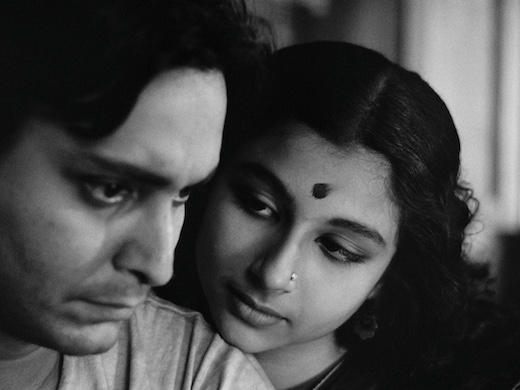How Do You Prefer the Films of ‘The Apu Trilogy,’ Solo or In Toto?
The set of films by the pioneering Indian writer and director Satyajit Ray, “Pather Panchali” (1955), “Aparajito” (1956), and “Apur Sansar” (1959), are now available on Blu-Ray from the Criterion Collection.

The Criterion Collection maintains that “Pather Panchali” (1955), “Aparajito” (1956), and “Apur Sansar” (1959), a set of films by the pioneering Indian writer and director Satyajit Ray, can be enjoyed as individual entertainments notwithstanding the through-line of their stories. Ray adapted these pictures from a pair of novels by a Bengali writer, Bibhutibhushan Bandyopadhyay (1894-1950), about the fortunes and frustrations of a poverty-ridden family whose ancestral home is in a distant rural outpost.
Anyone who has seen the pictures on an individual basis will likely concur about their stand-alone integrity. Still, following Criterion’s recent release of “The Apu Trilogy” on Blu-Ray, I have to demur, if just a bit, after having watched it in toto. Following the entire continuity of our protagonist’s travels — from birth to his becoming an itinerant 30-something — is a gripping experience not only because of our investment in the character, but because we see how Ray gets his bearings as a director. “Pather Panchali” is an epochal achievement, but “Aparajito” and “Apur Sansar” are more fluid as cinema.
The rawness of the first film endows its proceedings with a gritty verisimilitude. It’s a wonder Ray pulled it off at all. The 31-year-old graphic designer had no experience in making movies, nor did his cinematographer, Subrata Mitra, whose speciality was still photography. Ray had the wherewithal to hire Bansi Chandragupta as production designer: He’d done some work with Jean Renoir, at least. The guy responsible for the soundtrack, Ravi Shankar, was also new to the game.
If the crew of “Pather Panchali” was green, the actors weren’t much more experienced: the majority were amateurs. The script? Ray never polished it off because, you know, the thing was in his head. Filming was a higgledy-piggledy affair due to financial problems. Ray would ultimately complete the film with money provided through political connections and the commendation of John Huston, the actor, writer, and director. The Hollywood triple-threat was scouting locations in India, saw some of Ray’s rushes, and told the higher-ups at the Museum of Modern Art that here was a director worth investing in.

A rushed and unsubtitled version of “Pather Panchali” had its premiere at MoMA in May 1955. The following year Ray’s picture was feted at the Cannes Film Festival. By 1958, the film had become an art house staple. Watching it in 2023, you can’t help but take note of the movie’s discursive rhythms. Surely audiences back in the day had patience for this kind of thing? Apparently not: The Times thought it a “chore to sit through” and the New Republic termed it “simple almost to the point of banality.”
Banal? “Pather Panchali” most certainly isn’t, but it does unfold with deliberation. It’s also rife with moments of startling poetic depth. In one scene, Apu (Sabir Banerjee) and his older sister Durga (Uma Dasgupta) wander far afield from the family’s shambling jungle home and come across some power lines. They respond to them with something approaching agape. The year is 1921. Modernity hasn’t entered their lives. The Roys have no electricity or running water. The whistle of a distant train is a harbinger of an alien world.
Other than Apu, a role assumed by different actors during the course of “The Apu Trilogy,” the most indelible character is Indir Thakrun, the aunt to Apu and Durga. Chunibala Devi, a theatrical actress who appeared in films during the 1930s, was coaxed out of retirement at the director’s insistence. She was into her eighth decade during the filming of “Pather Panchali,” but she appears much older, what with her bent frame, skeletal visage, and take-no-guff attitude. Once seen, Auntie Indir is not easily forgotten.
“Aparajito” and “Apur Sansar” follow Apu through adolescence, adulthood, and marriage — the latter of which is arrived at through farcical means and is enlivened by the otherworldly beatitude of Sharmila Tagora as Apu’s bride, Aparna. When Aparna’s original bridegroom proves himself not to be suitable material for marriage, Apu is catapulted into the union. Apu and Aparna come to love each other, though sorrow follows upon its course. “The Apu Trilogy” doesn’t stint on tragedy.
In “Apur Sansar,” Apu tells an old school friend that his ambition is to become a writer on the scale of Charles Dickens. It’s a fitting reference in that Ray’s trilogy has a correspondence with “David Copperfield,” another lengthy coming-of-age story whose sundry longueurs end up illuminating the constancies and contradictions of what it is to be human. Although the films in “The Apu Trilogy” aren’t necessarily Ray’s finest achievement — “Charulata” (1964) is my vote for that particular designation — they are, in the end, inescapable components of world cinema.

